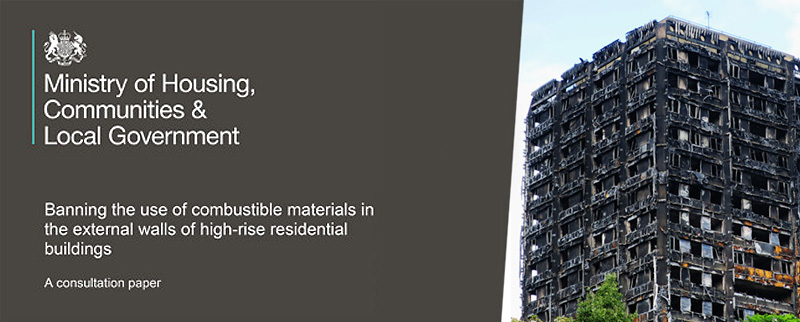
Consultation description
The Secretary of State announced the launch of a consultation on banning the use of combustible materials on the external walls of high-rise residential buildings.
This proposal is in line with the Secretary of State’s commitment in Parliament on 17th May 2018 to consult on banning the use of combustible materials in cladding systems on high-rise residential buildings. In line with this consultation, which closed on the 14thAugust 2018, the Government has produced Draft Part B Approved Documents, which are currently in open consultation.
Background
The Building Regulations 2010 (as amended) require that external walls on all buildings adequately resist the spread of fire over the walls and from one building to another (Paragraph B4 of Schedule 1). Statutory guidance in Section 12 of Approved Document B on Fire Safety Volume 2 (Buildings other than Dwelling Houses) sets out two ways that external walls may meet the Building Regulations requirement for resisting fire spread:
The first is for each individual component of the wall (surface, insulation, filler, etc.) to meet the required standard for combustibility.
The second is to ensure that all the combined elements of a wall, when tested as a whole installed system, adequately resist the spread of fire in accordance with the (British Standard) BS 8414 test.
This guidance should be read in conjunction with Appendix A of the Approved Document B which outlines how tests should be carried out for the performance of materials, products and structures and establishes the principle of assessments in lieu of tests. The Department has consulted separately on such assessments.
Since the Grenfell Tower fire there has been much debate about compliance and interpretation of these provisions. Similarly, some have argued that the BS 8414 test is not sufficiently robust. The Government stands by the advice issued by the Expert Panel that wall systems that have met BS 8414 can be considered to be safe if they have been correctly installed and maintained. However, Government has heard the concerns of many that combustible cladding is not explicitly banned under statute.
Dame Judith Hackitt’s independent review has identified serious failings with the construction industry and the regulatory system and has proposed a radical approach to address them. Reform of the scale envisaged by Dame Judith and by the Commons Select Committee will take time and the Government, in response to public concern, considers that in addition to longer term reform there is also a case for immediate action in relation to external fire spread. Dame Judith also indicates that when choosing between products that are non-combustible or of limited combustibility and products undergoing full-scale system tests, the lower risk option is to use products that are non-combustible or of limited combustibility.
The Government response to this consultation will also take into account any emerging findings from the Public Inquiry into the Grenfell Tower fire.
Proposed Approach
As noted above, currently there are two ways to demonstrate compliance with Building Regulations requirements in Approved Document B. The second of these – the BS 8414 test – is well established and has been developed over a number of years under the auspices of the British Standards Institution (BSI). This test method is also recognised in other international jurisdictions.
Recent concerns expressed about the test are being considered by the relevant technical committee of the BSI. The Government agrees with the advice of the Expert Panel that systems which have passed the BS 8414 test and have been correctly installed and maintained and therefore meet Building Regulations guidance, provide a safe way to ensure that wall system will resist the spread of fire.
However, the Government also recognises the concerns that the BS 8414 test does not offer as straightforward a way of meeting the requirements of the Regulations as would a ban on the use of combustible materials. We also note Dame Judith’s view that using products which are non-combustible or of limited combustibility is undoubtedly the lower risk option. The Government therefore considers it right to consult on a ban which would as a consequence remove the flexibility offered to cladding design by the BS 8414 test on high-rise residential buildings.
It is expected the changes will be through legislation by amending the Building Regulations to include a specific ban. Failure to comply with the ban would be a breach of the Building Regulations 2010. Those not complying would be open to prosecution in the Magistrates’ Court. The Court has powers to impose an unlimited fine.
The Government had considered amending the guidance in the Approved Document B as an alternative to specify what materials should be used, but as the guidance in Approved Documents is not mandatory it would not deliver the policy intention of a complete ban.
As we have separate Guidance Documents in England and Wales the Welsh Government has now issued a similar consultation.
Welsh Government Combustible Material Ban Consultation
The Welsh Government are proposing to ban the use of combustible materials in the inner leaf, insulation and cladding that are used in external wall systems on high-rise residential buildings. This Consultation closes on 13thSeptember 2018.

